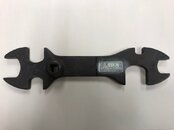One interesting side note, I recently learned of a shop in Europe that removes DIN valves by screwing a tool into the DIN fitting, rather than using a wrench. My local dive shop still just uses a big adjustable. I had considered firing up my Clausing Colchester & cutting the DIN threads into a piece of bar stock, so that I could have a tool like the shop in Europe, but I have concerns about the O-ring seating face getting damaged under stress caused by that kind of tool. I'm still kicking that idea around in the back of my head.
Been doing it that way for over 30 years. Most DIN Valves do not have outside flat surfaces, at least in Europe, so that is the approved way to remove DIN (G5/8") valves. Since front corners on the round bar stock are rounded off slighty to make engaging the rod easier there is no way to damage the flat at the back of the G5/8" fitting. Removing the valve is easy too - insert the bar into the valve, lay the tank down on rug covered surface and roll the tank with your foot - hard. If the valve doesn't loosen up (happens often on taper threaded valves using teflon tape or lead boots) repeat a couple of times.
Michael




 ). Making impact tools out of aluminum is also a no-no, the ability of alum to cold weld into the threads will not result in being a happy camper.
). Making impact tools out of aluminum is also a no-no, the ability of alum to cold weld into the threads will not result in being a happy camper.